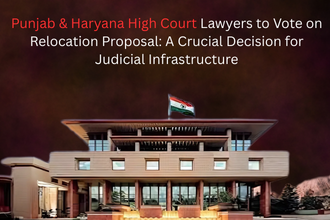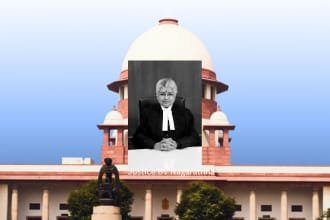Introduction
The Punjab and Haryana High Court, located in Sector 1, Chandigarh, is at the center of a significant debate: should the court remain in its current UNESCO-protected location or be shifted to a new site at Sarangpur village? The Punjab and Haryana High Court Bar Association (PHHCBA) has decided to resolve this question democratically by conducting a vote among its members.
The issue has arisen because of serious infrastructure challenges, limited expansion possibilities due to UNESCO World Heritage restrictions, and the urgent need for additional courtrooms and facilities. The outcome of this vote will shape the judicial infrastructure of the region for the next two decades.
Why Relocation is Being Considered
The High Court currently operates from a complex that forms part of the Chandigarh Capitol Complex, designed by Le Corbusier and recognized as a UNESCO World Heritage site. While historically significant, this location imposes strict restrictions on construction and expansion.
Key Concerns at Current Site:
- The High Court lies in the catchment area of Sukhna Lake, limiting environmental modifications.
- UNESCO heritage status means that structural changes require global committee approvals, which are time-consuming.
- The High Court has a sanctioned strength of 85 courtrooms, but only 69 are functional, leading to a severe space crunch.
- Judges and lawyers regularly raise concerns about overcrowding, lack of parking, and infrastructure stress.
Given these issues, two proposals are now under consideration: expansion at the current site or relocation to Sarangpur.
The Two Proposals Explained
1. Expansion at Current Location
- A new complex could be constructed opposite the PHHCBA Bar Room.
- It would include 16 new courtrooms, three above-ground floors, and two levels of underground parking.
- Estimated cost: ₹200 crores.
- However, this requires UNESCO approval, which may take 1.5 years or more.
- Construction is expected to take five years, during which congestion, dust, and parking reduction will cause inconvenience.
2. Relocation to Sarangpur Village
- A 48.865-acre site has been earmarked at Sarangpur within Chandigarh.
- Of this, 15 acres have already been allotted.
- Proposed area: 42 lakh sq. ft. dedicated exclusively for the High Court.
- The new complex would have entry and exit from four directions, with multiple gates for smoother flow.
- Planned metro connectivity, flyovers, and wider roads would improve access.
- The Bar Association claims this location can meet infrastructure needs for the next 20–25 years.
Both projects are estimated to take 5–7 years, but relocation promises greater long-term benefits.
Judicial Intervention
On August 22, 2025, a Division Bench of Chief Justice Sheel Nagu and Justice Ramesh Kumari emphasized the need for general body approval before such a historic decision could move forward.
Key Judicial Observation:
- “This is a very important decision, unless the general body agrees, I don’t think we should go ahead,” remarked the Chief Justice.
- The Court directed that the Executive Committee’s resolution be placed before the General Body of the Bar Association for approval.
This judicial insistence on a democratic vote reflects the importance of lawyers’ participation in shaping judicial infrastructure.
PHHCBA’s Stand
The PHHCBA Executive Committee, on August 20, unanimously approved relocation to Sarangpur. In its notice to members, the Association highlighted:
- Expansion at the existing site would mean congestion, blockades, and reduction of parking space during construction.
- The UNESCO approval process is uncertain and would delay immediate relief.
- Relocation offers a clean slate with sufficient space for expansion for decades.
- Sarangpur will benefit from planned metro stations, major road connectivity, and a flyover from PGI side.
The Association urged its members:
“The decision is yours for which you must cast your valuable vote.”
The voting process and dates are expected to be announced soon by PHHCBA Secretary Gagandeep Jammu.
Infrastructure Challenges at Current Site
The Chandigarh Capitol Complex is globally significant, but it was never designed to meet the needs of a rapidly expanding judiciary.
- Growing pendency of cases requires more judges and courtrooms.
- With only 69 operational courtrooms, the High Court struggles to function at full capacity.
- The heritage restrictions make even basic infrastructural upgrades difficult.
- The existing space crunch negatively impacts litigants, lawyers, and judicial officers alike.
Pros and Cons of Relocation
Advantages of Shifting to Sarangpur
- Adequate land and space for 20–25 years.
- Modern infrastructure with better planning.
- Traffic decongestion with multiple access points.
- Alignment with Chandigarh’s future urban planning (metro, roads, flyovers).
Disadvantages
- Sentimental value of existing heritage complex.
- Long-term construction timeline (5–7 years).
- Potential administrative and financial challenges in relocation.
Advantages of Staying at Current Site
- Preservation of historical and architectural continuity.
- Lower cost (₹200 crores) compared to relocation.
Disadvantages
- Restricted expansion due to UNESCO guidelines.
- Long delays in international approval processes.
- Inconvenience during construction (dust, congestion, parking issues).
Implications for the Judiciary and Litigants
This decision will have far-reaching implications:
- For lawyers: Improved facilities will directly impact working conditions, efficiency, and case management.
- For litigants: Faster hearings and reduced pendency through better infrastructure.
- For judicial independence: A stronger, self-sufficient complex symbolizes institutional strength.
- For urban planning: Relocation would integrate judicial infrastructure into Chandigarh’s broader development roadmap.
Conclusion
The proposal to relocate the Punjab & Haryana High Court is more than just an infrastructure decision—it is about balancing heritage preservation, environmental concerns, and the pressing need for judicial efficiency. While expansion at the current site is possible, it comes with limitations and uncertainties. On the other hand, relocation to Sarangpur village promises long-term sustainability and modern infrastructure.
As the PHHCBA members prepare to vote, the decision they make will define the future of justice delivery in the region for the next generation.
The Bar Association’s democratic approach ensures that this critical decision will reflect the collective wisdom of the legal fraternity, marking an important moment in the history of the Punjab and Haryana High Court.
Also Read
Himachal Pradesh High Court: Saying ‘Pakistan Zindabad’ Is Not Sedition Unless India Is Denounced



